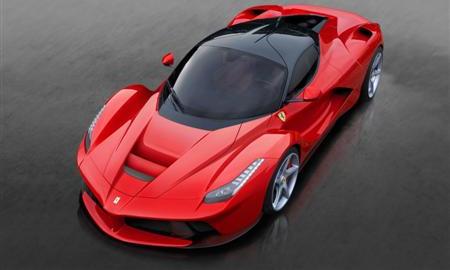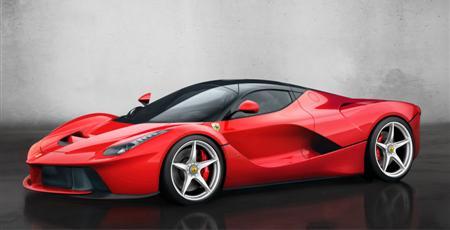|

 Production will be limited to 499 examples.
Production will be limited to 499 examples.
|
|
|
Ferrari LaFerrari revealed
Home >
News >
Ferrari
Recent new car releases ..... here
Upcoming new car releases ..... here
8th April, 2013
Ferrari took the wraps off their hybrid sports car, the LaFerrari, last
month. The limited-series special will see just 499 examples made.
“We chose to call this model LaFerrari,” said Ferrari’s President, Luca di Montezemolo, “because it is the
maximum expression of what defines our company – excellence. Excellence in terms of technological innovation, performance,
visionary styling and the sheer thrill of driving. Aimed at our collectors, this is a truly extraordinary car which
encompasses advanced solutions that, in the future, will find their way onto the rest of the range, and it represents the
benchmark for the entire automotive industry. LaFerrari is the finest expression of our company’s unique, unparalleled
engineering and design know-how, including that acquired in Formula 1.”
Hybrid
For Ferrari the development of a limited-series special like the LaFerrari represents an opportunity to experiment
with all the technological solutions that will later filter down onto the production cars. Of particular significance in
this context is the introduction of the hybrid system which, making full use of the Scuderia Ferrari’s F1 KERS know-how,
has resulted in a solution that exalts Ferrari’s fundamental values – performance and driving thrills.
The hybrid technology used, known as HY-KERS, represents the combination of maximum performance and improved
emissions. LaFerrari emits 330 g/km of CO2 but without resorting to electric-only drive which would not fit
the mission of this model. The HY-KERS system is, however, designed so that in future applications a car can be driven
using exclusively electric power for a few kilometres and, during development testing, a full-electric version of
LaFerrari achieved 220 g/km of C02 emissions on the combined cycle.
The Ferrari LaFerrari is equipped with dynamic controls that are integrated for the first time ever on a Ferrari road
car with active aerodynamics and the HY-KERS system. Thanks to Ferrari’s proprietary logic which govern all the systems,
the car can achieve absolute levels of performance, aerodynamic efficiency and handling without any form of compromise in
any area. A very advanced and uncompromising approach was also taken with the interior design which features an HMI
inspired by F1 single-seaters.
Architecture
The LaFerrari’s architecture posed the first challenge for the Prancing Horse team at the planning stage of the
design.
The aim was to achieve ideal weight distribution (59% at the rear) and a compact wheelbase despite the extra bulk of
the hybrid system. The result is that all of the masses are situated between the car’s two axles and as close as possible
to the floor to lower its centre of gravity (by 35 millimetres) and thereby provide dynamic handling and compact
dimensions.
The lay out of the cabin made a significant contribution in this regard. The seat is fixed and tailored to the driver
while both the pedal box and steering wheel are adjustable. The driving position is similar to that of a single-seater
and was designed after consultation with the Scuderia Ferrari drivers, Fernando Alonso and Felipe Massa, who played an
active role throughout the entire development process.
The LaFerrari’s chassis features no less than four different types of carbon-fibre, all hand-laminated and
autoclave-cured in the racing department using the same design and production methods as the Formula 1 car. This helped
optimise the design: various functions were integrated (e.g. seats and battery compartment) into the chassis to improve
torsional rigidity (+27%) and beam stiffness (+22%) whilst cutting weight.
Powertrain
The LaFerrari is the first car in Ferrari history to be powered by the HY-KERS system. The ICE represents the pinnacle
of engine development and research, with a 6,262 cc V12 that punches out 800 CV and revs to a maximum of 9,250 rpm. It
also features a very high 13.5:1 compression ratio and a high specific output equal to 128 CV per litre. The engine is
coupled with a 120 Kw (163 CV) electric motor, giving it a combined power output of 963 CV.
The high torque levels available at low revs from the electric motor allowed the engineers to optimise the internal
combustion engine’s performance at higher revs, thus providing a constant supply of exceptional power throughout the rev
range.
Total torque generated is in excess of 900 Nm.
The hybrid system is composed of two electric motors developed in collaboration with Magneti Marelli – one powering
the driven wheels and the second the ancillaries – and a battery pack attached to the floor of the chassis consisting of
cells that are assembled in the Scuderia Ferrari department where the KERS for the F138 is also made. The Scuderia’s
expertise allowed considerable savings in weight and size of the individual components and the batteries weigh just 60 kg
while providing the highest energy density possible for this kind of application.
The batteries are charged in different ways: under braking (even hard braking with the ABS active) and every time the
V12 produces more torque than required, such as in cornering. In the latter instance, rather than the being sent to the
wheels, the excess torque is converted to energy and stored in the batteries.
The electric motor is coupled with the F1 dual-clutch gearbox to the benefit of optimal weight distribution, but also
to boosting energy efficiency as torque is instantly available to the wheels and, vice versa, from the wheels to the
electric motor in recharging.
Aerodynamics
Active aerodynamics play an essential role, as they allow a complete adjustability of the car’s configuration to
attain LaFerrari’s exceptional performance.
|
|
|

Self-Catering Holiday
Accommodation in
Denmark, WA
..... more
|
|
|
The engineers’ aim was to deliver the highest degree of aerodynamic efficiency ever achieved with any road car, with a
coefficient of nearly 3, thanks to technical solutions honed with CFD analysis and fine-tuned in the F1 Wind Tunnel.
To boost efficiency, the LaFerrari sports active aerodynamic devices front (diffusers and guide vane on the underbody)
and rear (diffusers and rear spoiler) which generate downforce when needed without compromising the car’s overall drag
coefficient. These devices deploy automatically on the basis of a number of different performance parameters which are
monitored in real time by the car’s dynamic vehicle controls, thus guaranteeing the ideal configuration on the basis of
the driving conditions.
Control systems
One further innovative aspect of the LaFerrari is the integration of its active aerodynamics and hybrid system with
the other dynamic control systems aboard. This means the car responds to driver inputs, making for a seamless blend of
performance and driving emotions.
Proprietary Ferrari algorithms deliver integration of the electric motor and V12 for instantaneous response. In
cornering, for instance, the HY-KERS keeps the V12’s revs high to guarantee better acceleration on exit.
The LaFerrari’s Brembo braking system is also integrated with the hybrid system, and incorporates several new
features, including new lightweight callipers designed to guarantee correct cooling and carbon-ceramic material (CCM)
discs featuring a new composition.
The car’s extreme performance potential called for a different tyre set-up, with 265/30 R 19 Pirelli P-Zeros on the
front and 345/30 R 20s on the rear.
All in all the car provides maximum driving thrills in many situation and performance levels are top level: 0-100
km/h in less than 3 seconds and 0-200 km/h in under 7 seconds, a lap time at Fiorano of under 1’20” – 5 seconds faster
than the Enzo and over 3 seconds faster than the F12berlinetta. LaFerrari is thus amongst the fastest road cars in
Maranello’s history.
Styling
The Ferrari design team led by Flavio Manzoni developed the LaFerrari’s styling working in close synergy with the
engineers to emphasise the exacting link between form and function. The result is an extreme, innovative design which
retains close links to the marque’s tradition. This is most evident in its side profile: the car has a sharp,
downward-sloping nose and a very low bonnet which emphasises its wheelarches, a clear nod to the gloriously exuberant
forms of late-1960s Ferrari sports prototypes.
The LaFerrari’s body has been given a sculptural treatment heavily influenced by its clearly F1-inspired aerodynamics
and a tail section that exudes uncompromising sportiness.
Inside there’s a newly-designed steering wheel sporting all the major commands, and the gear-shift paddles are now
longer and more ergonomic. The signature bridge on which the F1 gearbox functions are clustered has taken on a sleek,
suspended wing-like shape. The whole interior, in fact, has a fiercely track-inspired, pared-back allure.
TECHNICAL SPECIFICATIONS
HY-KERS system
Total maximum power: 963 CV
Total maximum torque: >900 Nm
V12 maximum power**: 800 CV @ 9,000 rpm
Maximum revs: 9,250 rpm
V12 maximum torque: 700 Nm @ 6,750 rpm
Electric motor output: 120 Kw (163 CV)
CO2 emissions***: 330 g/km
Performance
Maximum speed: over 350 km/h (where legal)
0-100 km/h: <3 sec
0-200 km/h: <7 sec
0-300 km/h: 15 sec
ICE
Type: 65-deg. V12
Bore and stroke: 94 x 752 mm
Total displacement: 6,262 cc
Compression ratio: 13.5:1
Specific power: 128 CV/l
Dimensions
Length: 4,702 mm
Width: 1,992 mm
Height: 1,116 mm
Wheelbase: 2,650 mm
Weight distribution: 41% front, 59% rear
Gearbox
7-speed DCT
Suspension
Front: double wishbones
Rear: multi-link
Tyres(Pirelli P-Zero)
Front: 265/30 - 19
Rear: 345/30 - 20
Carbon ceramic brakes (Brembo)
Front: 398 x 223 x 36 mm
Rear: 380 x 253 x 34 mm
Electronic controls
ESC stability control
High performance ABS/EBD, Performance anti blockage system/electronic brake balance
EF1-Trac: F1 electronic traction control integrated with the hybrid system
E-Diff 3: third generation electronic differential
SCM-E Frs: magnetorheological damping with twin solenoids (Al-Ni tube)
Aerodynamics: active
NOTES:
** with dynamic ram effect
***Undergoing homologation
E&OE.
|